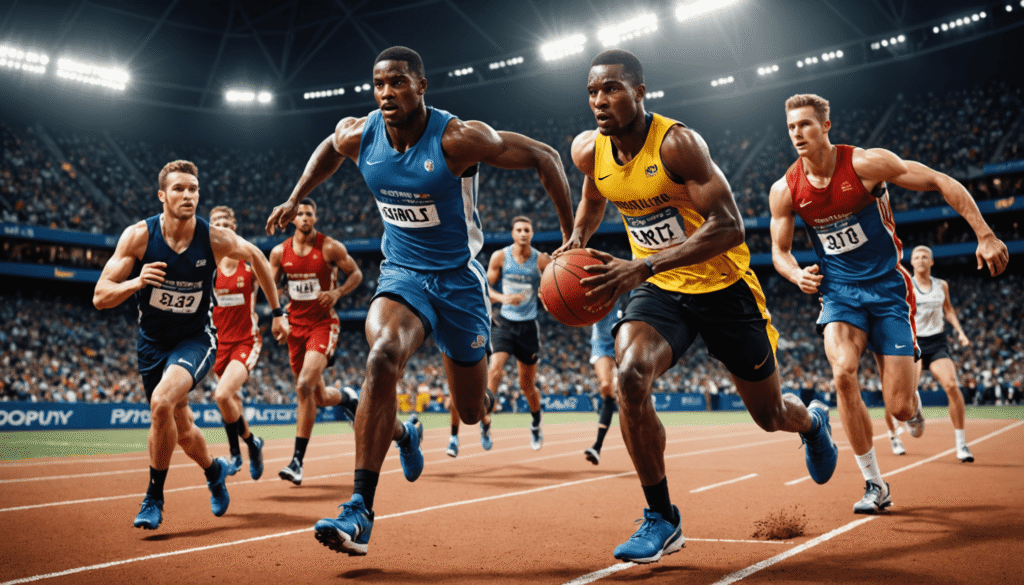
Ever wonder how an athlete in a sport like pickleball—yes, pickleball—ends up making real money?
You’re not alone.
Ben Johns, one of the top figures in the sport, is turning heads not just for how he plays, but also for how he earns. He isn’t just swinging a paddle; he’s navigating a growing ecosystem of sponsorships, digital marketing, and smart personal branding.
And here’s the wild part: it’s not just about winning on the court anymore.
Athletes today are crossing over into digital spaces, monetizing content, building audiences, and turning those eyeballs into income.
So the question becomes less about “How much does Ben Johns get paid to play?” and more about “How many different ways is he getting paid?”
Let’s break down how someone like Johns rides the intersection of athletic skill, branding, and online influence—because the model he’s building might just be a glimpse into the future of elite athletic compensation.
Introduction – The Intersection Of Sports Compensation And Digital Marketing
Ben Johns didn’t just show up and dominate the pickleball scene. He reshaped what a paddle sport athlete could look like financially. Before he came along, few people thought of pickleball as a career path, let alone one that could support a full-blown athletic empire.
But here we are.
As his name shot to the top of tournament brackets, something else happened: brands started paying attention. First it was sporting goods. Then came fitness tech, lifestyle brands, and even nutrition companies.
Why?
Because with every win and every appearance, Johns helped drive a surge of interest in a sport many thought was just another backyard game. And with more eyeballs came more dollars.
Now people are asking the right question: Not just “what’s his salary,” but “how is he structuring his revenue?”
It’s a simple equation—get results, build a following, monetize it smart.
And digital marketing has cracked things wide open. Athletes aren’t just staying in their lane anymore. They’re creating content, launching digital products, and operating like media brands.
Which brings us to the real takeaway: Sports isn’t just about playing anymore. It’s a platform. And people like Johns are showing how to use it.
Ben Johns’ Biography And Professional Background
Born with a natural edge and perfected with elite-level training, Ben Johns is more than just the face of pickleball—he’s its cornerstone. He got into the sport early and didn’t wait around to take over. With every groundstroke and overhead, he’s managed to rack up dozens of titles and constantly stay at the top of the Professional Pickleball Association rankings.
His reputation? Clinical.
He’s the player everyone prepares to face—and rarely beats. That consistency has earned Johns something no marketing budget can buy: credibility.
But even legends need exposure. And as pickleball’s popularity exploded—thanks in no small part to social media, streaming coverage, and viral highlights—Johns was ready.
He wasn’t just racking up trophies; he was capturing moments people wanted to see.
Sponsors noticed.
From paddle endorsements through Selkirk Sport to branded appearances, Johns transformed his game into a business. And as the sport matured, so did his earning routes.
Where some athletes coast on talent, Johns used every win to deepen his grip—on the sport and the market behind it.
The difference? Strategy.
He wasn’t just playing to win.
He was playing to build.
Ben Johns’ Earnings: An Analysis
If you’re imagining that pro pickleball players are raking in tennis-style millions, slow down—but don’t discount the momentum.
Ben Johns earns through a smart mix of tournament winnings, brand deals, and content-based income. It’s what you’d call a diversified athlete business model.
Let’s look at how it plays out.
- Tournament winnings: In 2024, the PPA Tour Championship featured a $500,000 prize pool, with singles champions taking home $50,000.
- Sponsorships: Gear brands like Selkirk Sport and Franklin Sports have long-term relationships with top-tier athletes. That includes equipment fees, bonuses for podium finishes, and sometimes licensing royalties.
- Endorsements: He also benefits from broader lifestyle partnerships, leveraging his personal brand across nutrition, fitness, and wellness sectors.
Dig a little deeper and Johns’ path becomes clear. As prize pools rise—thanks to increasing fan interest and commercial sponsorships—his direct earning potential scales up.
To be clear, this isn’t just about the top line prize money.
What moves the needle are contracts with brands. These are structured deals with fixed base payments and performance incentives. While the actual dollar amounts aren’t public, they’re likely well into six figures annually when you factor in visibility, results, and fan engagement.
Take this example:
| Revenue Stream | Source | Impact |
|---|---|---|
| Tournament Winnings | PPA Tour Events | Direct cash earnings; anchors credibility |
| Brand Sponsorships | Selkirk, Franklin Sports | Majority of recurring income |
| Social Media Content | Instagram, YouTube | Attracts additional sponsors; monetizes engagement |
Stack that up against athletes in similar rising sports—think eSports, disc golf, or CrossFit—and you start seeing the blueprint.
Ben Johns isn’t just trying to win matches.
He’s trying to own the court and the conversation that follows.
It’s about being where the attention goes—and having a product (himself) that brands want to align with.
And that’s the game within the game.
Unpacking Digital Marketing Compensation and Content Creation Trends
When people ask about Ben Johns’ salary, they’re not just curious about prize money. The real money—at least, the scalable kind—is increasingly circling around something that didn’t exist in sports a decade ago: digital marketing. For athletes, especially in niche but exploding sports like pickleball, building a strong digital game is quickly becoming just as important as having a strong physical one.
Social media isn’t just a way for players to connect with fans. It’s a full-blown revenue engine. Major platforms like Instagram, TikTok, and YouTube have become central to how modern athletes stack income streams beyond the court. A strong post-game recap or training tip can generate more engagement than some televised matches.
Take Instagram. It’s not just a highlight reel anymore. Analysts from Nielsen Sports reported in 2023 that athletes boasting 100,000+ followers could land endorsement deals worth anywhere from $10,000 to $50,000 per post. What brands really want? Engagement. Reels that spark conversations, DMs that turn into buzz, and stories that feel authentic. Think less polished ads, more genuine moments.
Then there’s YouTube, where many athletes drop tutorials, match breakdowns, even day-in-the-life vlogs. Each view might only yield pennies in ad revenue, but sponsorship reads, affiliate links, and platform bonuses build the stack. TikTok adds another layer, rewarding viral hits with Creator Fund payouts and branded opportunities. In effect, today’s athlete is also a content creator.
- Exclusive coaching tips: monetized via Patreon or subscription-based platforms
- Live Q&As and clinics: streamed on Twitch or YouTube Live
- Product reviews: often sponsored, mixed with personal advice
The biggest shift? Athletes now think like influencers. They understand personal branding, audience growth, and creator economics. And it’s not just side income—it’s core strategy. Ben Johns may not flash his earnings, but his expanding online footprint suggests he’s ahead of the curve in using attention as currency.
The overlap between digital influencers and top athletes is no longer blurry—it’s fused. Their efforts are targeted, timely, and tailored to keep followers locked in and sponsors coming back. Pickleball may still be growing, but the business blueprint is scaling fast.
Sponsorships and Social Media in Sports Marketing
What drives most of the real money behind athletes like Ben Johns? It’s not just tournament winnings. It’s sponsorships—backroom deals, brand alignments, and endorsement contracts that reward not only performance, but presence.
In up-and-coming sports like pickleball, the sponsorship playbook is evolving fast. While big sports have million-dollar gear deals, emerging players are cashing in smartly with mid-range partnerships. Equipment brands like Selkirk and Paddletek are increasingly investing in faces that can move product across both digital and in-person channels.
Several factors affect how these deals are structured:
- Audience reach: More followers means more visibility, especially among niche enthusiasts.
- Engagement rate: A smaller but loyal fan base often trumps massive but inactive followings.
- Marketability: Style of play, personality, and how well they represent the lifestyle of the sport.
One player’s brand may scream elite athleticism; another might lean into approachability and grassroots appeal. Sponsors love both, depending on who their customers are. That versatility makes players like Ben Johns prime candidates for wide-ranging deals—from paddle sponsors to athletic apparel to energy drinks.
What makes it all even more vital? Social platforms. Athletes no longer rely on TV air time. Instead, they shape their narrative directly through reels, short-form content, and authentic behind-the-scenes looks. For Johns, this authentic access is worth its weight. Fans know his style, routines, even warm-ups—and that’s influencer-grade intimacy.
Plenty of athletes now tailor everything from captions to camera angles to ensure their brand resonates in seconds. It’s deliberate. It’s smart. And it works. Who follows them—and how they interact—impacts dollars. Followers at key demographics (think age, location, spending habits) drastically shift what brands are willing to pay.
So while we don’t have a line-by-line of the Ben Johns salary, what’s clear is this: sponsorship value is inseparable from digital presence. As the sport scales, expect social metrics to shape contracts more than ever. Even the analytics being pitched to sponsors now resemble influencer proposals: impressions, click-through rates, and engagement funnels.
In essence, a player’s bankability no longer ends when they leave the court—it gains traction when they log in, hit publish, or share another peek into life behind the paddle.
Emerging Trends in Sports Compensation Models
Let’s be real — the days of athletes relying solely on tournament checks or league contracts are fading fast. Players are shifting from traditional pay structures to smarter, hybrid compensation models. We’re in a new era where influence, brand, and digital presence hold as much weight as raw talent.
Ben Johns? He’s a textbook case of where it’s heading. While nobody’s leaked exact numbers on Ben Johns’ salary, we know enough from watching the sport to piece it together. Professional pickleball is catching fire — not just as a game but as a full-on industry. Player earnings aren’t just numbers on a prize check anymore; they’re built on a mix of cash flows.
Here’s what’s changing:
- Prize money’s just the base. Think of it like a salary floor rather than the ceiling.
- Sponsorships = real fuel. Companies like Selkirk Sport or Franklin Sports are writing checks for gear deals and brand ambassadorship.
- Digital monetization ramps it up. YouTube, Patreon, Insta — athletes are turning attention into income.
We’re seeing athletes explore paid memberships, online coaching packages, and exclusive digital content. Suppose you’re one of the top five pickleball players. If you’re not making money off tutorials or behind-the-scenes content, you’re basically leaving cash on the table. Fans want access. Real-time insights. Bonus material. And they’ll pay for it.
But here’s the key: none of this works without self-branding. Athletes who build a recognizable, trusted personal brand are the ones pulling ahead. Followers, not just stats, drive deals. A player with a strong social presence? They’ve got more leverage negotiating deals. A weak presence? You’re just another guy trying to make quota.
For every Ben Johns, there’s a handful of lower-ranked players who tried and fizzled out. The difference? Those who win offline AND online dominate. Just look at tennis. Or even chess. Players with digital profiles are commanding more than their analog-only peers. The game’s changed. And athletes who adapt fastest win.
Comparative Insights: Compensation Across Sports and Industries
Let’s zoom out. Curious how Ben Johns’ salary stands up across the broader sports and creator landscape? The crossover between sports marketing and digital influencer earnings is closer than you think — and way more interesting than it sounds.
Top-tier influencers with engaged followings pull in ad revenue, sponsorships, and recurring income through platforms like Patreon and Substack. Now compare that to a pro athlete’s income: same structure, different medium. The sport gives you the audience. Digital gives you the cash flow. That’s the overlap.
The difference? Stability. Influencers may rely on brand deals that change monthly. Athletes, like Johns, have competition schedules and steady visibility. But here’s what they both need: a traffic engine. Whether it’s fans, followers, or press, visibility is the commodity.
There’s also the career arc to consider. Athletic careers are short: one injury, and you’re out. But the creator model? That’s sustainable. Many athletes are now speeding up this transition:
- Create during the career: Build a digital brand before retirement.
- Launch content products early: Courses, merch, memberships.
- Use sport as the platform: Let the performance build your name.
In established sports like basketball or football, we’ve seen this for years. LeBron, Serena, even folks lower down the chain — they’re using social platforms just as well as sports agents. But emerging sports like pickleball? They’re just starting to unlock this formula.
If you’re Ben Johns, the blueprint’s already there. The question isn’t if he can match earnings from more popular sports — that’s tough when prize pools start at five figures. The real upside comes from building an ecosystem around the sport: gear, courses, branding, media gigs.
Other athletes should be watching closely. Because what’s working for Johns? It’s replicable. That combination of competition + content creates a flywheel. Play the game. Grow your name. Monetize attention. That’s modern sports, period.
Ben Johns and the Future of Sports Compensation
What happens when one of the best-known pickleball players collides head-on with massive digital opportunity? You get a case study for the future. While Ben Johns’ salary isn’t front-page public, the signals are all there.
Pickleball’s popularity is exploding — mainstream coverage, brand activations, even ESPN slots. Johns is already topping podiums. What’s next? Media appearances, signature gear lines, maybe even ownership stakes in leagues or teams. Expect his earnings to evolve fast. He’s not just playing pickleball anymore. He’s building a business around it.
He’s also playing smart. By tapping into digital platforms — Instagram, coaching platforms, even YouTube — Johns future-proofs his career. He doesn’t need to win forever. He just needs to keep the brand relevant. That alone carries lifelong income potential.
Imagine this: Johns builds a coaching community where thousands of fans pay to access drills, Q&As, and advanced tactics. He partners with a platform that syndicates pro pickleball matches. He sells training kits online. That’s not a pipe dream — it’s what’s already working in MMA, golf, and even esports.
Here’s what we can all learn from that:
- Your sport is your stage. Your brand is your revenue.
- Social media isn’t extra — it’s a core business channel.
- Influence magnifies performance. Not the other way around.
The bottom line? Athletes like Ben Johns aren’t just dragging emerging sports into legitimacy — they’re rewriting how athletes think about money. He’s setting the new standard: win some games, then build a machine. That’s the future model. And you don’t need a global sport to make global money anymore.






